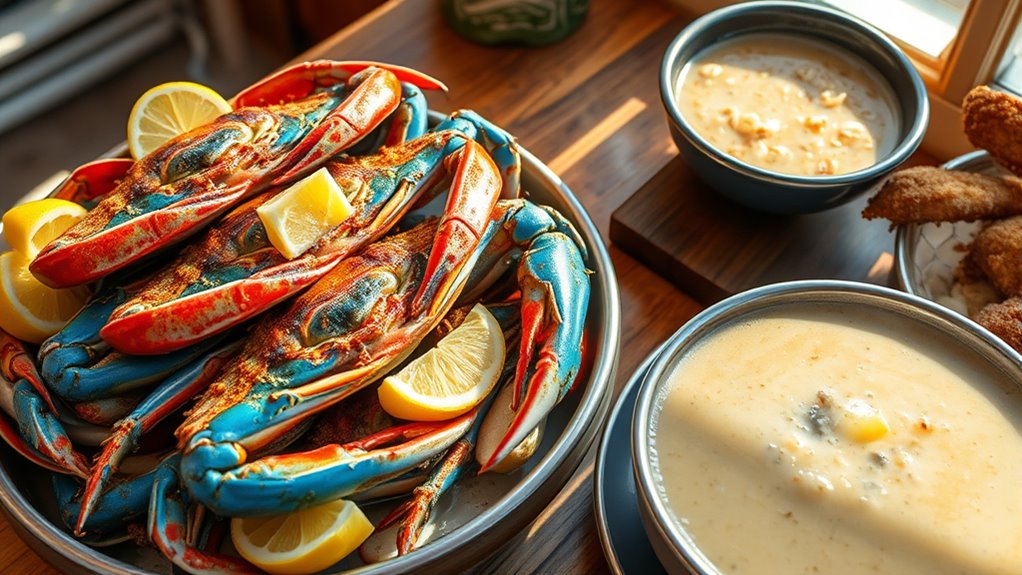Delaware’s cuisine blends indigenous, European, and early settler influences, giving you hearty dishes like scrapple, blue crab, and peach pie. You’ll find seasonal ingredients like peaches, strawberries, and seafood, preserved through jams and pickling. Traditional recipes reflect community celebrations and historic food practices, often passed down through generations. If you explore further, you’ll uncover how these culinary traditions continue to shape Delaware’s rich food culture today.
Key Takeaways
- Delaware’s cuisine blends indigenous foods like johnnycakes and wild game with European influences such as crab dishes and baked goods.
- Signature dishes include scrapple, blue crab, peach pie, and beach plum jelly, reflecting regional ingredients and harvest traditions.
- Preservation techniques like canning, drying, and pickling ensure year-round enjoyment of seasonal produce and seafood.
- Community festivals and heritage celebrations highlight traditional recipes, promoting cultural continuity and local food knowledge.
- Culinary practices emphasize food preservation, local ingredients, and family recipes, preserving Delaware’s rich food history and regional identity.
Indigenous and Early Settler Food Influences
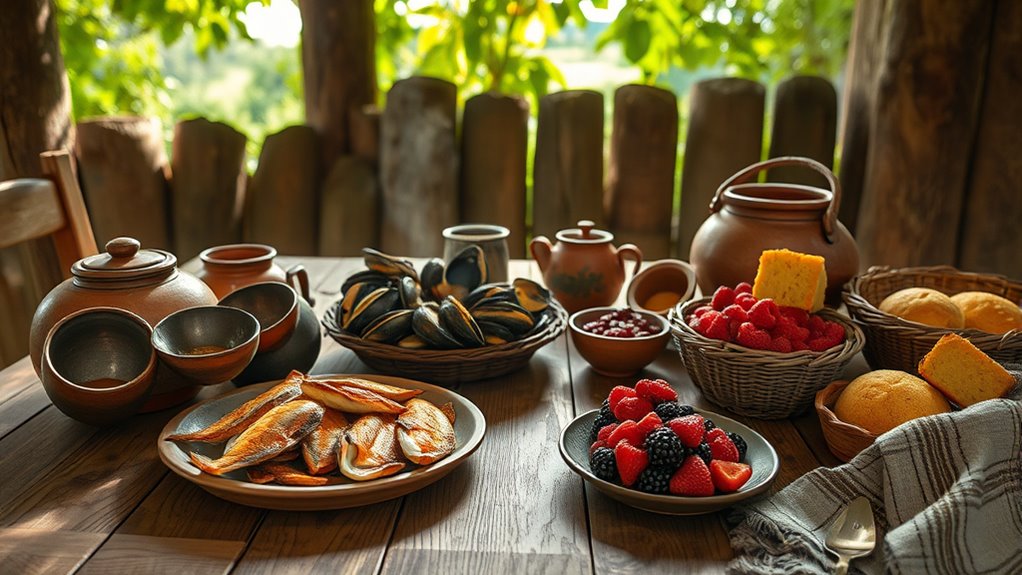
Have you ever wondered how Delaware’s early food traditions shaped its culinary landscape? The Nanticoke people, the region’s original inhabitants, set the foundation with hearty johnnycakes and wild game hunting, which became staples. When German settlers arrived, they brought scrapple—meat scraps mixed with grains—adapting to the local ingredients. Quaker colonists favored boiling methods, creating dishes like dumplings, puddings, and batter balls called “pop-robbins.” Their diet included cornmeal, venison, wild turkey, and dried beef, often preserved by boiling or simmering. These early influences blended with European traditions, resulting in a simple yet hearty cuisine. Food preservation techniques, such as boiling and drying, helped sustain communities through seasons, laying the groundwork for Delaware’s enduring culinary heritage rooted in indigenous and colonial practices. The use of cultural significance in cooking reflects how these traditions continue to influence modern Delaware cuisine.
Signature Dishes That Define Delaware Cuisine
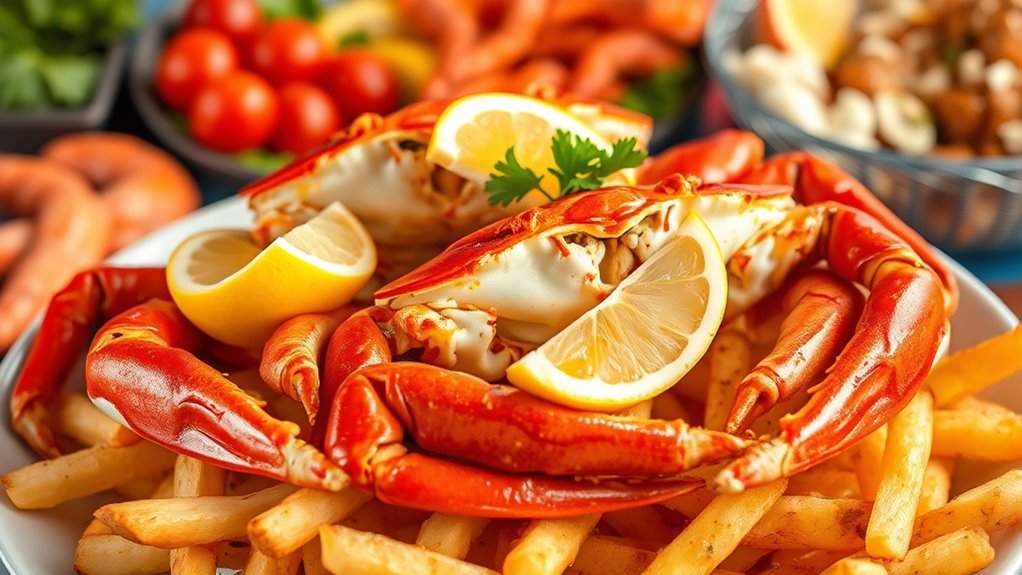
Delaware’s culinary identity is vividly shaped by its signature dishes that reflect both its rich history and local bounty. You’ll find scrapple, a beloved breakfast staple made from meat scraps and grains, fried until crispy and served with eggs. Blue crab from Delaware Bay is another defining dish, often enjoyed steamed with Old Bay seasoning or in crab cakes. Chicken with slippery dumplings, featuring delicate, thinly rolled dumplings, is a family favorite at gatherings. The sweet aroma of peach pie, celebrating Delaware’s historic peach farms, signals summer’s peak. Beach plum jelly and homemade preserves from local fruits also showcase the region’s seasonal harvest. These dishes embody the blend of Native, colonial, and regional influences that make Delaware’s cuisine uniquely comforting and flavorful. Cooking traditions have been passed down through generations, preserving the state’s culinary heritage.
Agricultural Roots and Seasonal Ingredients
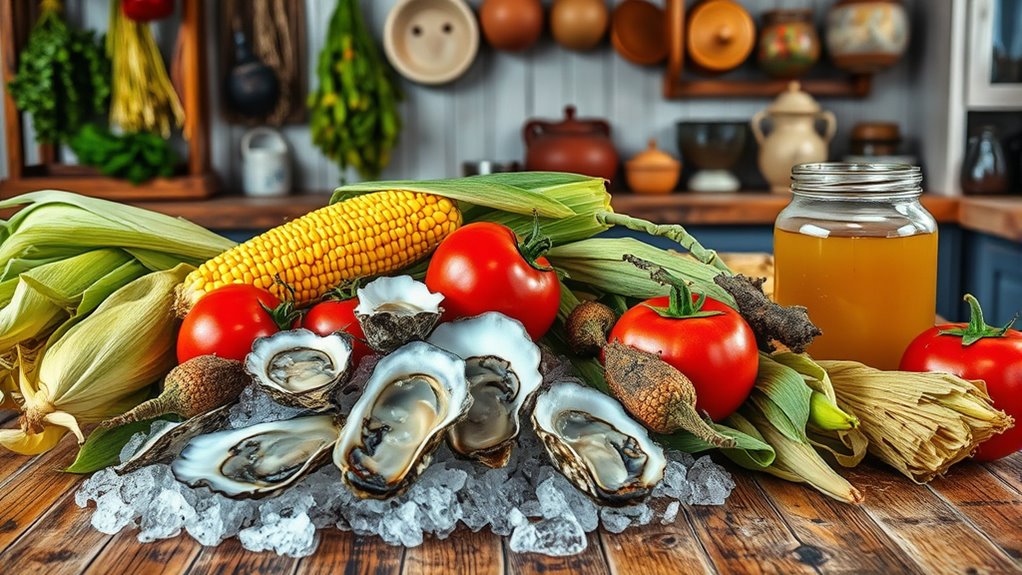
You notice how Delaware’s fertile land and waterways provide a steady supply of fresh seasonal produce like strawberries, peaches, and beach plums. Locals preserve the harvest through jams, jellies, and other techniques that keep summer’s bounty available year-round. Waterway-driven ingredients, such as seafood and wild game, also play a key role in shaping the region’s seasonal dishes.
Farm-Fresh Seasonal Produce
Fertile farmland and accessible waterways have long shaped Delaware’s culinary landscape, providing a bounty of fresh, seasonal produce that forms the backbone of local dishes. You’ll find strawberries, peaches, and beach plums at their peak during harvest seasons, inspiring jams, jellies, and desserts. Local farmers grow these fruits, ensuring you enjoy peak flavor and freshness. Wild game and seafood from nearby waters also enrich the seasonal menu, especially in spring and summer. You’re likely to incorporate these ingredients into family recipes passed down through generations, celebrating Delaware’s agricultural roots. Preservation methods like canning and jamming help you enjoy summer’s bounty year-round. Using fresh herbs and vegetables further enhances traditional dishes, connecting you to the land’s natural abundance and the region’s rich farming history. Remember to retain receipts to help verify purchases if you wish to participate in local farmers’ markets or promotions.
Preservation of Harvest Bounty
Harvesting Delaware’s bounty is only the beginning; safeguarding it ensures that seasonal flavors remain available long after the harvest ends. You can do this through various preservation methods that honor local traditions.
- Make jams, jellies, and preserves from summer fruits like strawberries, peaches, and beach plums.
- Dry herbs and vegetables for later use in hearty stews and soups.
- Can or freeze seasonal produce to enjoy fresh flavors year-round.
- Use traditional techniques like boiling and simmering to extend the shelf life of meats and seafood.
- Incorporate electric appliances, such as electric canners and dehydrators, to streamline food preservation and maintain energy efficiency.
Waterway-Driven Ingredient Use
Delaware’s waterways have long shaped its culinary landscape, providing a rich source of seasonal ingredients that define local flavors. You’ll find fresh seafood like blue crabs and oysters, especially in spring and summer, often steamed with Old Bay or turned into crab cakes. Wild game, such as venison and wild turkey, also comes from nearby lands, enriching traditional dishes. Preservation techniques, like making jams and jellies from beach plums and strawberries, help extend seasonal bounty. Local herbs and vegetables—like herbs and sweet corn—add depth to recipes like chicken and dumplings. This close connection between water, land, and seasonal produce creates a culinary tradition rooted in sustainability and regional abundance. Techniques such as sound synthesis can inspire innovative ways to capture the essence of these natural flavors in culinary presentations.
Colonial Introductions and Culinary Blends
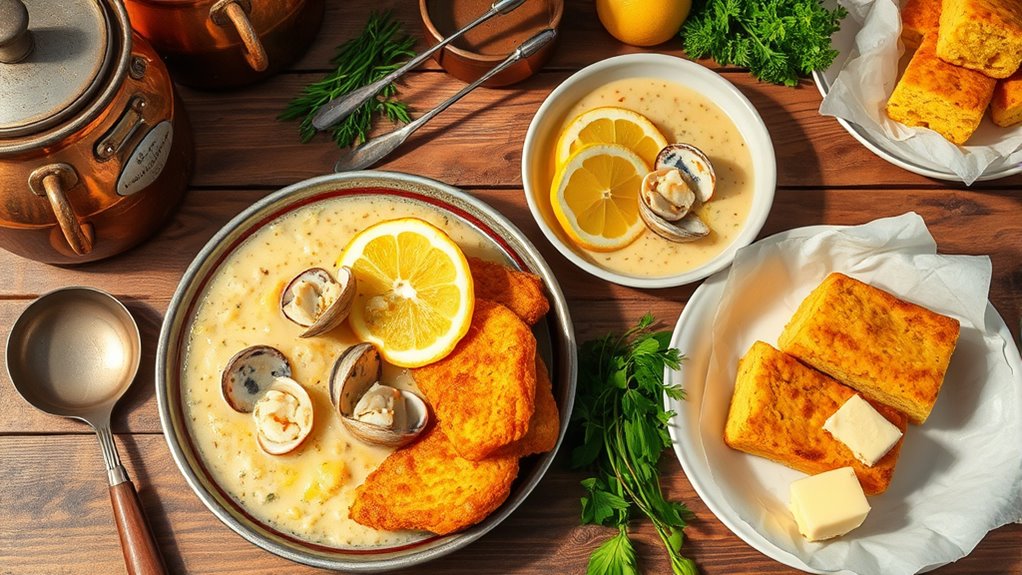
Colonial settlers brought a rich array of foods and culinary techniques that shaped Delaware’s traditional cuisine. You’ll find their influence in local dishes and cooking methods. Here’s a quick overview:
- Dairy products, rye bread, and preserved vegetables from Dutch and Swedish settlers, enriching local diets.
- Wheat, apples, and pies introduced by English colonists, expanding baking traditions.
- Cream cheese, originating with Quaker practices of warming cream, now a Delaware staple.
- European preservation methods, like pickling and drying, combined with indigenous techniques to develop unique recipes.
- Proper storage techniques, such as canvas waterproofing, were essential for preserving ingredients and supplies in the early settlements, ensuring food security during harsh seasons.
These influences blended seamlessly with native ingredients, creating a distinctive regional cuisine. The fusion of European traditions and local resources laid the foundation for Delaware’s diverse culinary heritage.
Celebrating Food Through Festivals and Traditions

You’ll find that Delaware’s food festivals and heritage cooking celebrations bring communities together to honor local flavors. Events like the annual scrapple contest and harvest festivals highlight traditional dishes and family recipes. These gatherings keep culinary traditions alive and connect people to Delaware’s rich food history. Additionally, these events often feature local specialties, showcasing regional ingredients and artisanal techniques.
Local Food Festivals
Have you ever experienced the vibrant energy of Delaware’s food festivals, where communities come together to celebrate their rich culinary heritage? These festivals highlight local ingredients and traditions, creating a lively atmosphere. You can expect:
- Sampling regional specialties like scrapple, crab cakes, and peach pie.
- Participating in cooking contests such as the annual Scrapple Recipe Contest.
- Enjoying seasonal events like strawberry and peach harvest festivals.
- Connecting with locals through storytelling and shared meals.
- Emphasizing the importance of credit card security during transactions to protect personal data.
These festivals serve as a platform to honor Delaware’s history and foster community bonds. They offer a chance to taste authentic dishes, learn cooking techniques, and celebrate agricultural bounty. Food festivals keep culinary traditions alive while welcoming new flavors and ideas.
Heritage Cooking Celebrations
Heritage cooking celebrations in Delaware bring communities together to honor the state’s rich culinary history through festivals, traditions, and shared experiences. During these events, you can enjoy traditional dishes like scrapple, crab cakes, and chicken with slippery dumplings, which highlight local ingredients and historic recipes. Festivals such as the strawberry and peach harvest celebrations showcase seasonal bounty, while contests like the World Championship Scrapple Recipe Contest celebrate culinary innovation. These gatherings often feature storytelling, passing down recipes and cooking techniques from generation to generation. You’re encouraged to participate in family recipes, learn about indigenous and colonial influences, and connect with others who share a passion for Delaware’s culinary legacy. These celebrations keep traditions alive and strengthen community bonds through food. Incorporating sustainable practices into these events can further enhance their positive impact on the environment and local communities.
Historical Cookbooks and Recipes From the Past

How did early Delaware cooks preserve and prepare their food without modern appliances? They relied on simple methods and basic tools. Historical cookbooks, like the Delaware Heritage Cookbook, reveal techniques passed down through generations. These recipes often used minimal equipment, focusing on practicality. Here are four key ideas:
- Boiling and simmering: Used for cooking meats and making puddings.
- Drying and curing: Preserved meats like dried beef and wild game.
- Standing and steeping: Created infusions and flavored broths.
- Simple tools: Bowls, spoons, and basic utensils supported everyday cooking.
Additionally, understanding drivetrain components helps appreciate the efficiency of traditional food preservation methods.
These methods reflect a resourceful approach, emphasizing local ingredients and preservation techniques that sustained early Delaware communities. They also laid the foundation for the region’s traditional dishes still enjoyed today.
Preserving Delaware’s Culinary Heritage
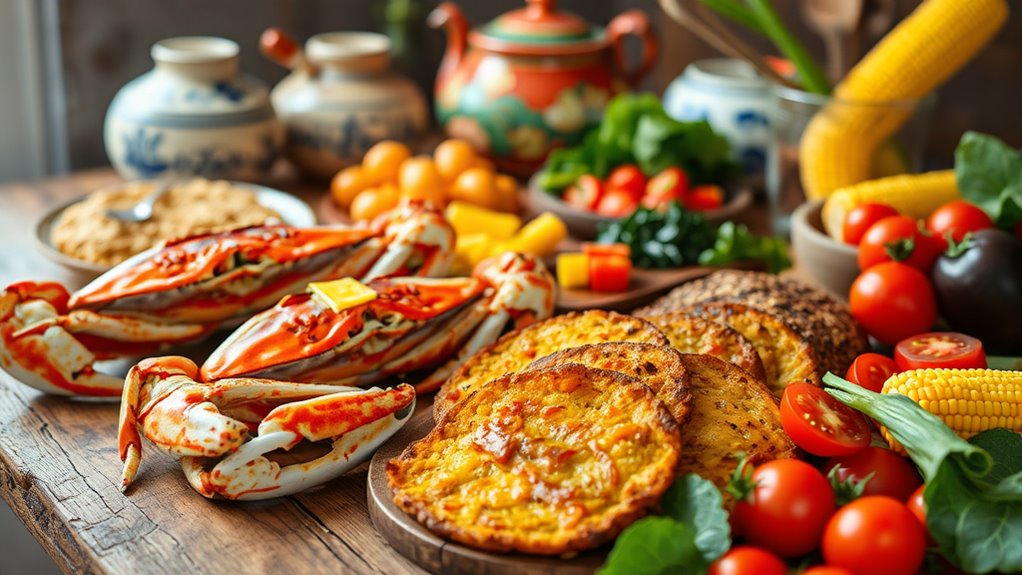
Preserving Delaware’s culinary traditions guarantees that the flavors and techniques of past generations remain alive today. You can do this by passing down family recipes, supporting local farmers, and participating in community festivals. These efforts keep regional dishes like scrapple, crab cakes, and chicken with dumplings vibrant. To illustrate, here’s a snapshot of Delaware’s culinary heritage:
| Food Item | Origin/Influence | Modern Significance |
|---|---|---|
| Scrapple | German settlers | Classic breakfast staple |
| Blue crab | Delaware Bay waters | Summer seafood favorite |
| Peach pie | Local peach farming | Summer harvest tradition |
| Beach plum jelly | Indigenous berries | Preserved regional flavor |
| Quaker puddings | Quaker cooking traditions | Cultural culinary link |
Through these traditions, you keep Delaware’s culinary legacy thriving.
Frequently Asked Questions
How Has Delaware’s Cuisine Evolved With Modern Culinary Trends?
You’ll notice that Delaware’s cuisine now blends traditional ingredients with modern trends like farm-to-table and sustainable practices. Chefs experiment with local seafood, reinvent classic dishes like scrapple and crab cakes, and incorporate fresh, seasonal produce. You can find innovative takes on historic recipes at food festivals and restaurants that celebrate regional flavors. This evolution keeps Delaware’s culinary heritage vibrant while embracing contemporary tastes and culinary techniques.
What Are Some Lesser-Known Traditional Delaware Dishes?
You might not find them on every menu, but lesser-known Delaware dishes are hidden gems waiting to be uncovered. Think hearty chicken with slippery dumplings that melt in your mouth or beach plum jelly that captures the summer sun. These recipes are like whispers from history, crafted with local ingredients and passed down through generations, offering a taste of the state’s rich, secret culinary tapestry that’s worth exploring.
How Do Indigenous Ingredients Influence Current Local Recipes?
You’ll notice indigenous ingredients like wild game, seafood, and locally grown fruits still influence your local recipes. For example, crab cakes highlight fresh blue crab from Delaware Bay, while beach plums and peaches flavor jams and pies. Traditional cooking methods like boiling and preserving with drying or canning come from indigenous and early settler practices. These ingredients and techniques connect you to Delaware’s rich culinary history and its ongoing seasonal, farm-to-table traditions.
What Role Do Immigrant Communities Play in Delaware’s Food Culture?
You might not realize it, but immigrant communities shape Delaware’s food scene more than you think. Their traditions, like Dutch dairy products and Swedish preserved vegetables, blend seamlessly into local dishes. These influences introduce fresh flavors and techniques, adding depth to regional recipes. As you enjoy a crab cake or peach pie, remember—each bite carries a story of diverse cultures coming together, enriching Delaware’s culinary tapestry in unexpected, delicious ways.
Are There Specific Cooking Techniques Unique to Delaware’s Culinary History?
You’ll find Delaware’s culinary history features specific techniques like boiling and simmering, passed down from Quaker traditions. These methods were essential for preserving food and creating hearty dishes like dumplings and puddings. You might also notice frying scrapple until crispy and steaming seafood with Old Bay, reflecting regional influences. These techniques highlight practical, resourceful cooking rooted in local ingredients and cultural practices, shaping Delaware’s unique food heritage.
Conclusion
As you explore Delaware’s culinary landscape, imagine a vibrant tapestry woven with threads of Indigenous roots, colonial influences, and seasonal bounty. Each dish and tradition adds a splash of color, creating a living picture of the state’s rich heritage. By honoring these flavors and stories, you become part of a timeless feast—where history and culture blend seamlessly on your plate, inviting you to savor Delaware’s unique culinary story with every bite.

